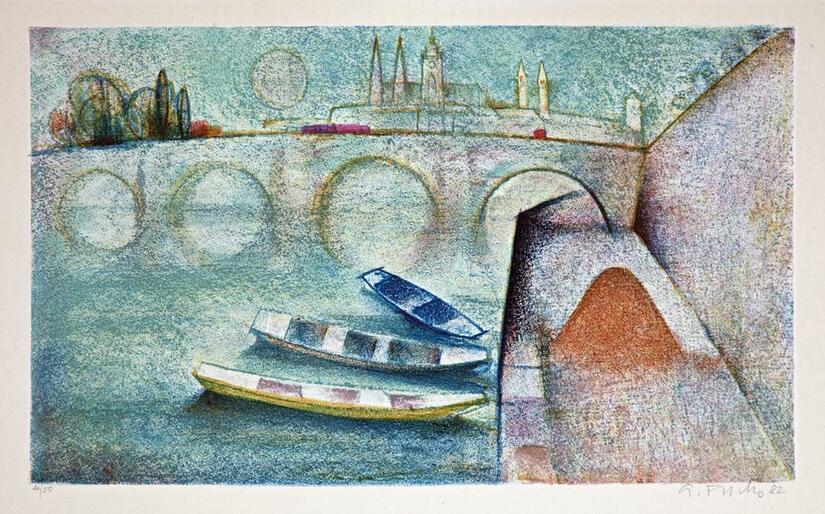Alfred Fuchs: Zyklus „Landschaften, Städte und Dörfer“ (Landscapes, Towns and Villages)

Drawings, here: "Three Boats and City View", 58 x 44 cm
The Academy shows seven landscape, town and village views by Alfred Fuchs, created between 1972 and 1988. Two views are of the city of which Fuchs said: "Prague is my mother." This example picture ("Three Boats and City View", 1982) shows the Hradcany, hinted at behind one of Prague's numerous bridges. The view goes from the Vltava directly to the castle, with colourful boats in the foreground and a lively Mediterranean atmosphere. In addition, the Academy will be showing drawings of Fuchs' Bohemian landscapes and villages as well as colourful drawings of sailing boats with French or Italian flags on the Mediterranean.
Beate Reifenscheid writes about this:
"If one approaches the works of Alfred Fuchs, it immediately becomes clear that cheerful serenity and colorful naivety determine his world of painting. (... He illustrates) that life can only be lived humanely with the eyes of a child, (...) with the curious appropriation of the world. (...) Colours and forms are reduced to the most elementary. In their simplicity they appeal to original recognition values." However, Alfred Fuchs is better known for his series of children's and anti-war drawings, some of which are also exhibited at the Academy. What his children's drawings and landscape drawings have in common is that they evoke the beautiful, idyllic and cheerful - as, according to Reifenscheid, "a search for traces of the memories of a happy, carefree childhood. A childhood that once began in Saarbrücken and which the Second World War and the persecution of the Jews brought to an abrupt end". (all quotations from: "Unter der Kerze ist Schatten - Das Leben des Malers Alfred Fuchs", ed. Arno Krause and Roswitha Jungfleisch, Gollenstein Verlag Blieskastel 2005, p. 185 - 187)
Alfred Fuchs (*1925 in Saarbrücken, Germany, †2003 in Prague, Czech Republic) was born as the second of three children of a Jewish father and a Christian mother in Saarbrücken. In October 1935 the family moved to Prague. Their hopes of escaping Nazi terror there were not fulfilled. Although the family survived, they were deeply affected by the experiences of flight, social ostracism, separation and imprisonment.
Alfred Fuchs can be assigned to contemporary figurative painting, but also works with elements of the Impressionists. His art clearly takes a stand against war and oppression and calls for humanity (series with anti-war drawings). Close to the viewer - although in a completely different way - are especially the drawings on the theme "Mother and Child". In them he deals with the longing for a carefree childhood as well as the loss of his little sister Adele. She arrived in Scotland on one of the Kindertransporte (children's transports) with which Jewish children could leave the German Reich for Great Britain in 1938/1939. There she found a new home, but after the war she remained a stranger to her original family. She had survived, but the Fuchs family had nevertheless lost their daughter.
In 1993 Alfred Fuchs exhibited together with Jaroslav Vaček, a Czech sculptor friend of his, who also has several works at the academy. Fuchs always stayed connected to the Europäische Akademie Otzenhausen, donated 39 paintings and since 1998 is its only honorary member.
The book "Unter der Kerze ist Schatten" by Sabine Graf about Alfred Fuchs' life, which the Academy published in 2005, is available here.